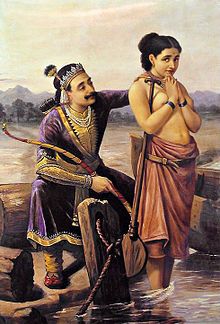Satyavati: Journey from Fisherwoman to Queen

Long ago lived a king named Uparichara Vasu of Chedi Kingom. He was an ascetic, learnt scholar and great follower of sages and Brahmanas. Once he was out in the forest on hunt. At night under the moonlight he got fascinated to uncontrolled desire of being with wife Ginika. He ejected his body fluid. In order to preserve the seed he picked the fluid in a leaf and ordered his pet falcon to give it to his wife Ginika. The falcon flew but mid-air it met another giant bird. The fight between the falcons resulted the leaf falling into a river flowing below.
One day a celestial nymph Adrika aroused in lust and with her uncontrolled desire reached near a sage meditating on the bank of a river. She tried to persuade him but the sage didn’t reply. Uncontrolled with the desires of copulation that young nymph went closer to the sage in order to unite with him. The sage got angry with her advancement. He cursed her to become a fish. Adrika cried. Cried to save her from the curse. Beholding the repenting lady, the sage altered the curse. He said, “You will be free once you give birth to human babies from your womb.”
The leaf fell into the river and the bodily fluid on the leaf was consumed by the fish. In turn, the fish (cursed Adrika) conceived . Months later, a fisherman Dusharaja on his duty caught the fish. Observing the overweight fish, he immediately cut it open, surprised to find two human figures, a boy and a girl.
Bewildered fisherman rushed to the king with the two infants. The king took the baby boy and named him Matsya. This boy later found Matsya Kingdom. (He was forefather of King Virat, whose daughter got married to Abhimanyu, son of Arjuna). Dusharaja took the baby girl, named Matsyagandha (one who smells like a fish). She was of dark complexion with a peculiar smell of fish comes from her body. Matsyagandha lived a simple life with her father. Because of true deeds, she was also called Satyavati.
Satyavati started helping his father in daily routine like ferrying passengers on river Yamuna. One fine day, Rishi Parashar was travelling on her boat. He looked at her and his desires roused. He wanted to unite with the lady of unusual smell but submissive beauty. The desires ruled and sage Parashar expressed his wish. The lady understood the determined sage and honoured the desires but put a condition. She said, “I stink like a fish and union in such unpleasant smell will not be fruitful.” The sage understood and with his Yogic powers turned the unpleasant smell to a musk fragrance.
The union impregnated the young lady and at due time she gave birth to a boy in an island on river Yamuna. The boy with the powers of Parashar born with unmatched intelligence. He was named as Krishna Dwaipayana (one with black skin tone and born on an island). Krishna Dwaipayana later compiled Vedas and narrated Mahabharata, later known as Ved Vyasa.
After giving birth to a boy, Satyavati returned to her hermitage and started following the routine of helping her father. Years later, Shantanu the king of Hastinapur noticed a lady on the bank of river while out on hunt. Enamoured with the unparalleled beauty and unavoidable fragrance and with the wish of marrying her reached out to her father and expressed his opinion.
This union though was not easy as Dusharaja, father of Satyavati put a condition before Shantanu. He said that the king can marry Satyavati only if the son born from their marriage would be the heir-next of the throne of Hastinapur. Shantanu couldn’t accept the condition as he already declared his other son Devavrata as heir-next of throne.
Devavrata, however, couldn’t see the deteriorating condition of his father took the pledge of remaining celibate for entire life. This “Bhishma” vow of Devavrata laid the path for Satyavati to walk from a shattered sanctum to the palace of Hastinapur. Satyavati and Shantanu got married. And Devavrata lived with the shackles of his vow.
I like Mahabharat stories to read so and often.I save them.